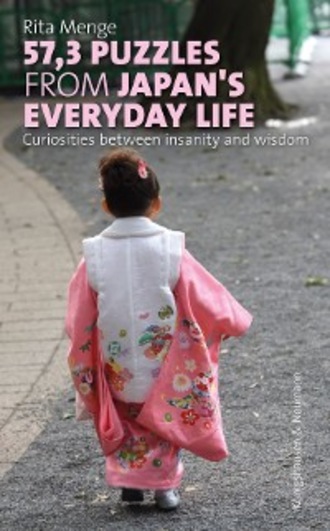
Полная версия
57,3 puzzles from Japan's everyday life

Rita Menge
—
57,3 puzzles from Japan’s everyday life
Rita Menge
57,3 puzzles from Japan’s everyday life
Curiosities between insanity and wisdom
Königshausen & Neumann
Biographical information of the German National Library
The German National Library lists this publication in the German
national bibliography; Detailed bibliographic data is available
on the Internet at http://dnb.d-nb.de. ©Publisher Königshausen & Neumann GmbH, Würzburg 2019 Printed on acid-free, age-resistant paper Cover: skh-softics / coverart Cover picture: Tiraimi: Siebenhundertdreiundfünfzig; #127573788 © Fotolia.com All rights reserved
This work including all of its parts is protected by copyright.
Any use outside the narrow limits of copyright law without the
consent of the publisher is inadmissible and punishable.
This applies in particular to reproductions, translations,
microfilming and the storage and processing in electronic systems.
Printed in Germany
ISBN 978-3-8260-8044-9
www.koenigshausen-neumann.de www.libri.de www.buchhandel.de www.buchkatalog.de
For my mother
She is a role model and a great inspiration to all of us.
Contents
Foreword
Chapter 1
Foreword
I decided to translate my book into an English version, because my Japanese friends asked me to do so. Please excuse any grammatical mistakes.
Japan is a mystery. It is simply completely different than any other country, of which also the Japanese themselves are firmly convinced. Even after many years of contact with Japanese culture, you always discovers new mysterious, funny, astonishing, curious and impressive things. Very often it is deplored that one or the other idea cannot be found abroad.
Two years ago I moved back to Japan. I’ve been living in Japan for two years, after a five-year stay in the 1990s and numerous business and leisure travel. When I came back, I quickly realized that almost daily I am confronted with things that are still surprising and often bring a smile to my face. Since many people are interested in Japan, I started to take photos and send them to friends as a quiz. The idea to put this quiz in a book format developed shortly after.
Interestingly, many of my Japanese friends and acquaintances could not solve many of my riddles, which has always led to amusement and amazement on both sides.
You might ask yourself: "Why 57.3 puzzles?" My intention was to provide with this the first puzzle for all interested Japan-fans. The resolution of this entry puzzle follows on the next page. You can look forward to 57 detailed secrets to guess and ponder, hopefully many surprising moments and interesting information while reading the resolutions. The three puzzles behind the comma are covered rather briefly at the beginning of the book and all deal with numbers.
In each case you will find a photo with the associated puzzle on the right page and the resolution with some backgrounds and explanations on the back of the photo.
The lines in italics at the beginning of each chapter serve to briefly elucidate the riddle for hurried readers.
What's up with the numbers five, seven, three that were used in the title?
Seven, five, three in Japanese Shichi, Go, San mark the age when many Japanese children are accompanied by their parents to the Shinto shrine, where they ask together for health and a secure future.
Usually, this shrine visit takes place every year around the 15th of November and especially the mothers and grandmother’s dress in a kimono. Also the children are traditionally dressed, but since a real kimono is very expensive, children's outfitting is usually borrowed on occasions like these. Afterwards, the entire family will visit a photographer to capture these beautiful moments.
The girl on the cover of this book is probably three years old and is on her way to the shrine with her family to celebrate her first feast.
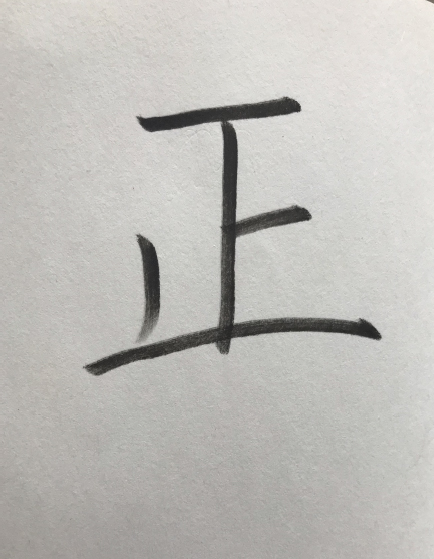
What does this sign mean?
This way, the Japanese make a five-digit tally.
While Germans place four strokes vertically next to each other and place the fifth diagonally across these strokes, the Japanese count in their own way. Thereby they create a Chinese character that has the meaning "correct" or "complete"
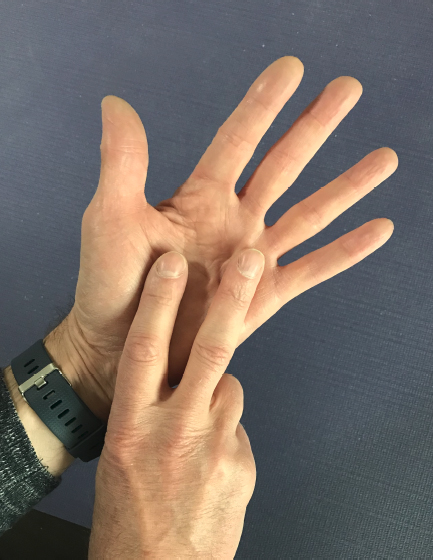
What is displayed here in body language?
Japanese express the number seven in this non-verbal way. The one is symbolized by an upraised index finger, the five by opening all the fingers of one hand and from six to nine, individual fingers are placed in the already opened other palm. The number ten is expressed by two open hands. A raised thumb as a symbol for the number one, which is common in Germany, is completely misunderstood. This gesture just means "perfect, good, cool".
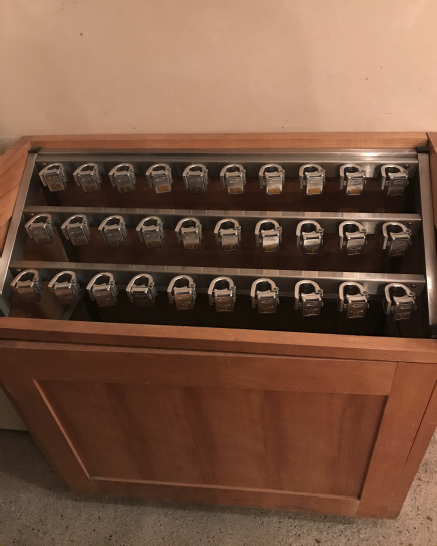
What is this?
This is a lockable umbrella holder. Such holders can be found in front of many shops, restaurants, government agencies and public institutions.
"Help, it's raining and I have no umbrella with me." This scenario is simply awful for many Japanese. On no account they want to get wet due to rain.
When the sky is cloudy it is not necessary to carry an umbrella, because if it actually starts to rain, you can buy cheap umbrellas for around € 3.00 in many shops, for example in the very numerous small 24-hour supermarkets. These umbrellas are transparent, which is sometimes very practical, especially when cycling with an umbrella. You can protect yourself by holding the umbrella in front of you and still see everything. Of course, this is forbidden, but sometimes it just has to be. Once you have arrived at your destination, there are now two ways to deal with the wet umbrella. Either you can dry it briefly. For this there are special devices available, through which the umbrella must be repeatedly moved back and forth, or you are asked to put the umbrella in a simple machine, in which it gets a plastic wrap. These measures are designed to keep the walkways in department stores dry, to minimize the risk of slipping and to additionally keep the floors clean.
The second possibility is, for example, at event locations or in some restaurants, to lock the possibly higher-quality umbrella into a holder, as shown in the photo, and to take the metal key with it. This service is of course free.
The crime rate in Japan is very low and theft is relatively rare. But if the umbrellas are all together in just one large umbrella stand, it can happen that someone simply takes one once it rains. This is not considered a theft, because these cheap umbrellas are usually simply left in a different spot when you no longer need them.
The operator of the DyDo vending machines for drinks came up with the idea to offer such lost-and-found umbrellas from the railways as umbrellas people can rent at many of his vending machines in the event of unexpected rain. Customers are asked to bring the loaned umbrellas back to a vending machine, which, according to company data, actually happens in 70% of the cases - without fees and on a basis of trust.
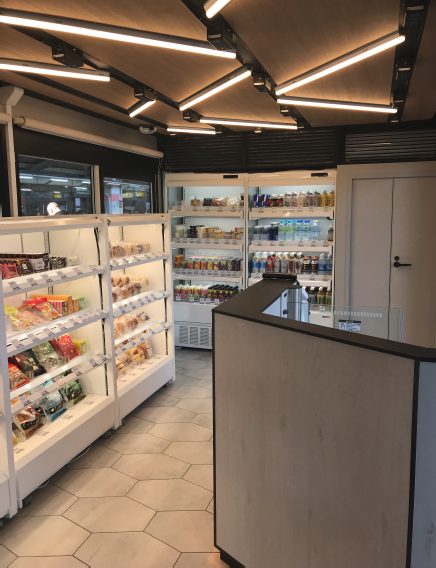
What is missing in this shop?
There are no employees in this experimental kiosk in a Tokyo train station. Everything happens automatically.
Imagine sleeping in a hotel and suddenly a female voice comes from the dark and asks you how she can help you. At such a moment for sure you immediately wake up in the middle of the night. And yet the communication robot only wanted to reply to your snoring. Welcome to the Henn na Hotel, Youtube: Galileo „Das japanische Roboterhotel“. The concept of this hotel was to have robots fulfill nearly all services. Unfortunately, the robots were annoying due to a number of malfunctions, so that some machines were shut down because guests complained.
The use of supporting technology is tested in many places in Japan and in the illustrated shop, the customers do everything themselves and pay, for example, with the Suica, a prepaid e-money card, almost every Japanese owns anyway. Access is only available if you hold a valid card to a reader. The store itself has dozens of cameras on the ceiling and shelves that record what the customer takes off the shelf. Before leaving the kiosk, the visitor holds his card back to a reader, receives a receipt and leaves the store. At the moment, this kiosk is in a two-month trial period and offers only a relatively small product range. Additionally, six employees explain the process to interested customers. This will surely change soon and little by little people will get used to self-service in supermarkets in Tokyo.
The Japanese economy has grown moderately and steadily for years and this rather unnoticed. Unemployment was recently at 2.2% and there are 163 job offers for 100 job seekers. Many branches of industry have been desperately looking for new workers for years, and today you can see much more foreign employees compared to 10 years earlier especially in small supermarkets and restaurants.
In April 2019, a new law will come into effect to make it easier for foreign workers to come to Japan to work here. In addition to the 1.28 million foreign workers, another 500,000 are to be added. Then the long-standing foreigner share of about 2% would rise somewhat, which does not appease all Japanese and also leads to heated discussions in parliament.
The Japanese have few reservations about using robots, such as exoskeletons, to lift heavy loads, and also in geriatric care, to make work easier.
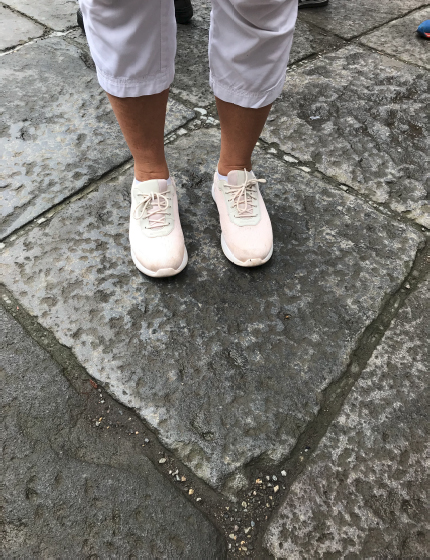
What is this stone´s meaning?
This is a power spot in Toshogu Shrine in the city of Nikko. There is to be a special power people can feel, through which they can recharge bodily and spiritual energy.
"You need more guests? Then just put something into nature and call it a Powerspot. „The Japanese are crazy about it“ a quote based on the Japanese movie “50 first kisses“.
You do not have time to visit one of these places? No problem! Already a photo of a power spot or a celebrity, such as Miwa Akihiro help to gain more energy. A smartphone owner already has more luck and a better feeling by simply using such a photo as the lock screen.
For many years people in Japan have relied on special places where the visitor is supposed to gain spiritual power. Japanese radio broadcasts, television reports and travel magazines are always providing new clues to mystical places. Many places in nature that have a special atmosphere are considered such places. Above all, of course, Mount Fuji (Fujiyama), other mountains, lakes, waterfalls and forests, but also many temples, such as the Meji Shrine in Tokyo or the aforementioned Toshogu Shrine in Nikko. This shrine is located amidst many old trees, for many visitors this has a very special aura that can certainly help to feel better. True hunters of the Powerspot know, however, that there is still a very special place, namely this stone. The Toshogu shrine was purposely chosen as his tomb by Tokugawa Ieyasu, who has united and pacified Japan. He consulted astrologers and scholars and commanded that his descendants should build a representative shrine here. In order to fulfill Ieyasus’ wish to be able to look on Edo (old name for Tokyo) as the pole star, the main gate was aligned exactly from west to east. The Polaris was considered king of the stars in Asia and stood in their center. Ieyasu drew lines between his birthplace, one of his earliest tombs (his tomb was repeatedly moved), Mount Fuji, Edo Castle, and the place of his burial in Toshogu Shrine. The result was an east-west line and a south-north line, which should extend to the Polaris. The stone is placed exactly where these lines converge. The Japanese stand in line to feel the special power of this place and benefit from the strength of Ieyasu as well as the radiance of the polar star. According to reports, the body should warm up while pausing in this place.
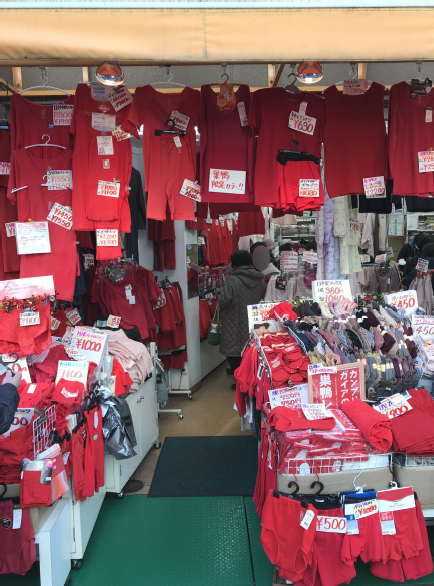
Why does this shop offer a huge selection of red underwear?
When turning sixty Japanese receive a lot of red things, also red underwear, which they are supposed to wear from now on.
Tourists from all over the world visit the Harajuku district of Tokyo to admire the latest youth trends, to eat crepes, to photograph themselves and then share this on social media. Tourists from all over Japan come to the Sugamo district of Tokyo to admire the latest fashion trends for the elderly, to eat delicious plain fare and to buy red underwear. It is just the "Harajuku of the old ladies and gentlemen".
First and foremost, you can buy everything in the same shade of red, from underpants, undershirts, socks to headdresses.
When asked why red underwear and the color red are generally so popular with Japan's retirees, there are several answers. First of all, the color red is simply supposed to bring luck. Some claim that according to Chinese medicine, it is supposed to stimulate an energy point on the navel, which consequently strengthens the circulation and thereby warms the body. Furthermore, the color red also has a psychological effect, the color is supposed to increase wellbeing and gives strength.
In Asian cultural history, explanations for this phenomenon can actually be found. The Japanese are of the opinion that when they turn sixty, their life begins anew, they finds themself in the so-called phase of Kanreki (return to the beginning of the circle). This is explained in the Japanese online lexicon "Wadoku" with the fact that in the Chinese calendar the cycles of ten calendar signs and twelve signs of the zodiac overlap and together restart after sixty years. A sixty-year old starts his life again, like a baby. Akachan (baby) literally translates from the Japanese to little red, which could explain the connection between the color red and the sixtieth birthday. The sixty-year-old traditionally begins a new period of life in which he hands over his family responsibilities to his eldest son and starts a carefree life with less responsibility.
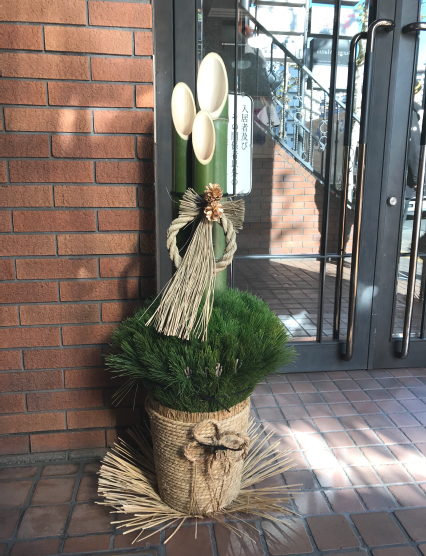
What is standing in front of this house entrance?
This is a typical home decoration that can be seen anywhere in Japan from the end of December to the seventh of January. It serves to greet the spirits of the ancestors and benevolent gods.
Traveler, when planning a trip to Japan you should carefully consider, if you want to do this at the turn of the year. Tokyo is a vibrant, cosmopolitan city, an oversized gourmet temple and a shopper's paradise? Yes, but...
Sometimes visitors read in guidebooks that New Year is the most important holiday of the year. The experienced travelers may think that this is interesting, but he does not need to care any further, because also on the numerous other public holidays in the year everything goes its well-lived course in Tokyo. However, celebrations around the beginning of the year are an extreme exception. Even big designer brands have closed down, every better restaurant closes for about a week, and even fast-food restaurants, dry cleaners, gyms and bars have a few days off. In short, Tokyo is in an annual state of deep sleep as everyone tries to travel back to their homeland to spend a few quiet days with the whole family coming from all directions. Many companies close for about a week and also the employees of smaller companies want to have a holiday. Of course, long-distance trains and planes are fully booked in advance.
There are countless New Year customs, which you absolutely must follow and you have to eat the New Year's food, in order to be lucky in the New Year.
The door decoration in the photo is called Kadomatsu (Door of Pine) and should greet the spirits of the ancestors, and thank the gods for the harvest. It stands as a couple to the right and left of the entrance and embodies husband and wife.
It is very important to greet everyone you meet for the first time in the New Year: Akemashite omedetou gozaimasu. Kotoshi mou yoroshiku onegai shimasu (Happy New Year, please treat me well again). As this is too long and too formal among friends, cool short versions are created, such as: Akeome kotoyoro.

What are you supposed to do?
Unfortunately, this hint, which is for tourists, is not as clear as it should be for everyone: It asks to throw the used toilet paper into the toilet and not into the wastebasket.
If you meet a foreigner in Japan with a large water stain on clothing, he may have become a victim of a toilet. Pictograms are great, as long as their meaning is clear. Unfortunately, some signs are not understood by all cultures. Since many tourists cannot interpret the signs correctly on the keyboards of the toilets, they often test their function for safety's sake once they are in front of the toilet with the result described above. This problem has been investigated by the toilet manufacturers by a survey and in 2017, the leading companies decided to unify the symbols on the toilets. There was a big press conference in which ten seasoned Japanese managers held a sign with the new toilet symbols smiling friendly into the camera. Anyone who does not know the characters of the flush for "big" and "small" should now be led to the flush button with a large and small water vortex. Honestly, these signs are rather reminiscent of wind.
There are many other symbols that should be changed for the better understanding for visitors. Overall, the renewal of 90 characters has already been considered. The new proposal for the sign Onsen (hot spring) also seems a little bizarre: So far this was characterized by three curved lines in a kind of tub. Now the silhouettes of three people are supposed to be added. Initial surveys expressed the opinion that the old sign looked like a noodle soup and the new like noodle soup with people in it. The resistance to change the old sign is also great amongst the Japanese population. In this case finding a new sign has not been successful yet.
As a student of the Japanese language, the same question arises as in the photo: "Why is a large red circle painted across my entire Japanese homework?" I hope this question arises as often as possible, because then the task is solved correctly. Unfortunately, students coming from the west probably are not pleased because they do not know the meaning of the sign. The cross means Batsu (no / bad) and the circle means Maru (yes / good). You can find these two signs amongst others as emojis, which unfortunately only Japanese interpret correctly right away.
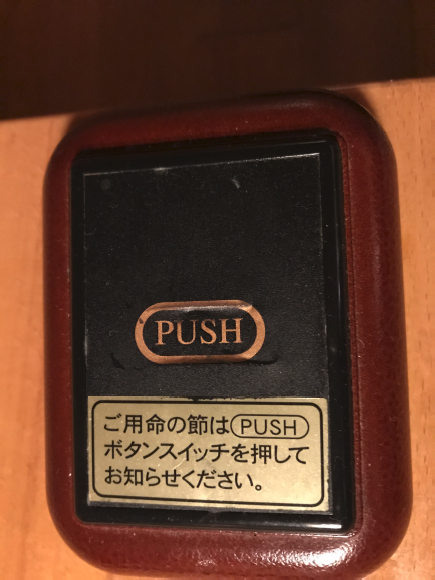
What do you do with this button, which is placed on the table in a restaurant?
With this button you can call the service, if you have decided to place an order.
Japanese restaurants are a true hoard of efficiency. This begins when entering the restaurant: you are immediately taken in, asked if you want to sit smoker or non-smoker, how many people come and then you are taken immediately to your place. Once there, you take a seat and get directly the menu. Now you have time to choose something and then call the waiter either with a well audible Sumimasen (sorry) or you find this practical bell button, which you simply press. An employee arrives instantly, picks up the order, repeats it for confirmation and immediately delivers it to the kitchen. Depending on the restaurant, it takes between two minutes to a maximum of 15 minutes till the first dish is served. It is particularly fast with dishes such as curry or noodle soups, because they are already prepared and, for example, only the noodles are freshly cooked. Very often, cooking is done in open kitchens in Japan, so you can see the preparation of your meal. Foods that need to be prepared freshly, such as sushi, tempura (fried vegetables), okonomiyaki (pancakes) or yakitori (grilled skewers) are quick to make and are the Japanese proof that fast food does not have to be classified as inferior quality. Usually guests also eat quickly, then often pay at the exit and leave the restaurant again. Especially when long queues have formed in front of a restaurant, the etiquette demands that you do not stay longer than necessary.
Of course, sometimes Japanese (or foreigners) want to spend a little more time in the restaurant, for example when going out with friends or family you can easily forget the time. In such a case, the waiter might point out that the usual two hours are exceeded and that you should clear the place for the following guests. For the Japanese, this is not a problem, they just move on to the nearest pub or bar. Foreigners often find this regulation, somewhat inappropriate, but many Japanese restaurants need their tables to be occupied several times to make enough revenue.

Why is there a Balinese hotel in the middle of Tokyo?
This is a so-called Love Hotel, which promises Balinese interior design. Here people can rent only hourly rooms from 11:00 am until 11:00 pm.
Do you want the spaceship, the simulated train compartment or rather the Disney version? Tourists often look for a special experience, here you can get it: One stay at an hourly hotel. Sometimes staying at the Love Hotel is the last chance for stranded tourists to find a bed for the night, which is often cheaper than a stay at a regular hotel. The allegedly best love hotels for travelers in Tokyo are even listed on Internet platforms.
In Japan, such hourly hotels can sometimes be found in an unobtrusive environment. Most Japanese do not consider these hotels to be dingy, as they are often used by people of all ages as well as family status. Even nowadays houses and apartments are still cramped and the walls are thin. It is still not common, except in the big cities, that young couples live together before marriage. Even couples who have children sometimes visit a Love Hotel. The reasons are probably different: on the one hand, the cramped living conditions, but some might also hope that the sometimes quite luxurious facilities of the hotels with fancy bathrooms or themed rooms create a special atmosphere. On a display in the entrance area the visitor sees the offered rooms. If you have decided, you press a button and pay at a counter, where you only see the hands of the employee. In the countryside, many Love Hotels are completely automated, visitors do not come into contact with any employee. Some are probably more likely to be afraid of being recognized if their companion is not their spouse. In the wake of the 2020 Olympics, the city of Tokyo fears that it will not be able to provide enough hotel rooms for its visitors and has begun to transform Love Hotels into normal overnight accommodations. Perhaps some visitors regret this measure and the opportunity to spend a very different kind of stay. But those responsible are probably just too embarrassed about the Love hotels and fear dubious reports in the international press. In fact, some Love Hotels have already begun to change their concept and at least partially turn into standard budget hotels for business travelers.



